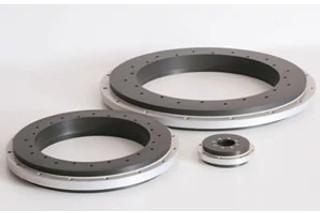Change Language :


1: igus®' wear data for its line of iglide® PRT sliding slewing ring bearings is based on how it performs on a rigid surface.
Slewing ring bearings are ideal for rotating and turntable-type applications. While understanding the design and performance capabilities of a slewing ring bearing is important, it is equally important to be aware of how certain mounting surfaces affect this type of bearing.
Whether a slewing ring uses ball bearings or sliding elements to facilitate movement, failure can occur if an improper mounting surface is used. If mounted to an uneven base, the wear surface of the slewing ring bearing will receive the majority of the load in an uneven pattern, and as a result; its load-handling capabilities can be seriously compromised.
Although a mounting surface may seem level, especially if it is soft like plexiglass or a thin sheet of aluminum for example, it can deform over time, especially with cantilevered loads. A steel or heavy-metal surface is best, particularly for applications with larger slewing rings and heavier loads.
3 Mounting Solutions

2: Mounting the slewing ring bearing to an even, rigid surface delivers the best performance.
Unfortunately, actual field applications often do not offer the perfect mounting surface. So it is important to keep in mind that whatever the surface, it must be able to withstand the weight of the slewing ring plus the load of the application.
Here are three different mounting solutions in order from most ideal to acceptable:
- Mount the sliding slewing ring bearing to an even and rigid surface – this is the most ideal scenario, as this type of surface will ensure the bearing is able to handle the calculated loads specified by the manufacturer.

3: iglide® PRT slewing ring bearings use high-performance polymer sliding elements instead of ball bearings.
- Before mounting the sliding slewing ring bearing, shim the uneven areas of the mounting surface – by making the surface area as even and smooth as possible, you decrease the chances of creating an extra moment load.
- Loosen the screws of the sliding slewing ring bearing – this tactic is recommended last, but by loosening the screws, the bearing will become more flexible and more able to operate on an uneven surface.
It is best to use one of these mounting tactics, but for certain applications, it simply might not be possible. If your only choice is to mount the slewing ring to a surface that is uneven or lacks rigidity, remember that the wear will significantly increase (at a rate dependant on the application) and potentially deform the bearing. This deformation can cause a binding or chattering effect. However, for a slewing ring using ball bearings, the failure will be almost immediate as the balls come free from the raceway. In comparison, a sliding slewing ring will require more torque to operate over time until it suddenly does not work.
Useful Links and Tools